The Many Advantages of a Small Tin Watering Can


Intro
The humble small tin watering can transcends mere utility, serving as a bridge between nature and décor. Its unique blend of functionality and aesthetic appeal allows it to shine both in gardens and interior spaces. As homeowners and designers alike begin to embrace the idea of incorporating practical items into their styling, the small tin watering can stands out, illustrating how even the simplest objects can elevate one's living environment.
Rather than merely existing in the realm of gardening, these cans have become a favored accent piece, adding a touch of charm that speaks of rustic elegance or contemporary flair, depending on their finishing touches and placements. With their ability to blend seamlessly into various styles, from the quaint cottage aesthetic to sleek modern designs, these watering cans are not just tools – they're conversation starters, eye-catching elements that invite admiration and intrigue.
Understanding the benefits of a small tin watering can not only enriches the gardening experience but also informs design choices in an era where blending functionality with design aesthetics is key. Whether you are looking to cultivate your home with vibrancy or nurture your garden’s health, this article will explore the vast potential that these cans hold in enriching both your practical tasks and your intimate spaces.
Prelude to the Small Tin Watering Can
The small tin watering can is often overlooked as a mere gardening tool, yet its relevance stretches far beyond simple horticulture. This article highlights how this unassuming object marries form and function, playing a pivotal role not just in nurturing plants but also as a stylish addition to any space. Homeowners, designers, retailers, and DIY enthusiasts will find value in understanding the myriad benefits associated with these cans.
The significance of the small tin watering can evolves from its historical roots and cultural symbolism to its practical applications in diverse settings. It serves not only as a watering device but as a testament to craftsmanship and aesthetic appeal. By diving into its history and the stories that shape its existence, the reader can grasp the broader context of why this piece remains relevant today.
Historical Context
Tracing back to its origins, the small tin watering can has a rich history that intertwines with human agriculture practices. Used since the early days of gardening, these tools were often handmade, reflecting the artistry of the period. Interest in gardening burgeoned during the Victorian era, heralding a surge in the use of decorative watering cans in English gardens.
Crafted primarily from tin, which was widely available and affordable, these containers became symbols of domestic life. As gardening evolved into an art form, the tiny tin watering can transformed, emphasizing both utility and design. Historically, they were often embellished with intricate patterns or vivid colors, making them not just tools but cherished objects.
Cultural Significance
The small tin watering can holds a notable place in various cultures around the globe. In many societies, it is associated with nurturing and care, representing the tender relationship between humans and the earth. For instance, in Japanese culture, the act of watering a garden is seen as a meditative practice, fostering harmony and mindfulness.
Additionally, these cans often symbolize home and warmth, appearing in art and literature as a metaphor for growth. They evoke images of idyllic gardens and cozy homes, where flowers bloom under attentive care. This cultural richness underscores the importance of the small tin watering can beyond its practical function, tying it to the greater human experience of nurturing life.
"The beauty of a small tin watering can is not just in its form, but in the stories it carries — stories of growth, care, and aesthetic appreciation across generations."
In summary, understanding the historical and cultural dimensions of the small tin watering can enhances our appreciation of its multifaceted benefits. As we explore further into design elements, practical uses, and eco-conscious options, one can truly capture the essence of this small yet impactful object.
Design Elements of the Small Tin Watering Can
The design aspects of a small tin watering can play a pivotal role in its overall utility and aesthetic charm. From the choice of materials to visual appeal, these elements not only contribute to the can's functioning but also enhance its integration into various spaces, whether they be gardens, terraces, or interiors. A well-designed watering can does more than just water plants; it embodies both form and function, making it a sought-after accessory in horticulture and home decor.
Materials Used
Types of Tin
When it comes to the types of tin used in watering cans, several factors dictate why certain options might be preferable. Tin is particularly valued for its balance between lightweight properties and structural strength. The inherent resistance to corrosion that tin possesses, especially when alloyed, makes it a favorable choice for gardening tools where exposure to moisture is a given.
Furthermore, the durability of tin enables these watering cans to last longer, even in outdoor settings. Users who often find themselves scrambling with heavier alternatives often appreciate how tin allows for ease of handling without sacrificing sturdiness. Despite this, one must consider that the thinner variations, while lightweight, could be prone to dents and thus require a gentle touch during use.
Coatings and Finishes
The coatings and finishes applied to small tin watering cans are vital for enhancing both aesthetics and longevity. Most commonly, exterior enamel coatings are utilized to prevent oxidation and to boost the visual appeal. These finishes can provide vibrant colors, resist fading, and introduce a smooth texture that’s easy to wipe clean. The importance of a good finish cannot be overstated; it not only amplifies the decorative qualities but also can deter rust formation that might shorten the can's lifespan.
Yet, it’s essential to keep an eye on the quality of these coatings. Cheaper alternatives may not hold up well under varying weather conditions; a quality finish ensures that a watering can remains looking crisp and modern while providing an additional layer of protection from the elements.
Aesthetic Appeal
Color Variations
Color plays a focal role in the appeal of small tin watering cans. The variety of shades available enables homeowners to select a can that complements their personal style or garden theme. Bright yellows or vivid greens can evoke a playful vibe, while muted pastels may appeal to those seeking a vintage or rustic aesthetic.
Moreover, color can extend beyond mere decoration; it can be a reflection of a gardener's personality. The right color choice not only beckons the eye but can create a cohesive look across multiple elements in a space, making gardening areas feel more tailored and inviting.
Design Styles
Design styles often dictate how effectively a small tin watering can fits into a given decor. From modern minimalist aesthetics to whimsical cottage charm, there are designs that cater to various tastes. A streamlined, sleek tin can might appeal to a contemporary home, while intricately designed handles or floral patterns could resonate with those who prefer a more traditional look.
A carefully chosen design can turn a simple tool into a statement piece, drawing the eye and sparking conversation.
With the recognition of diverse design styles, it becomes clear that a small tin watering can can transcend its practical use, serving as an unexpected focal point in a room or garden.
In summary, the design elements encompassing a small tin watering can—its materials, coatings, colors, and styles—are not just aesthetic choices. They contribute significantly to the function and overall satisfaction of the user, making it a worthwhile investment for anyone interested in both gardening and home decor.
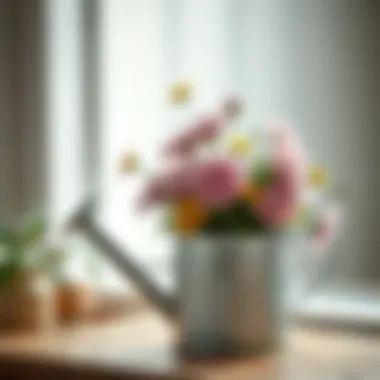
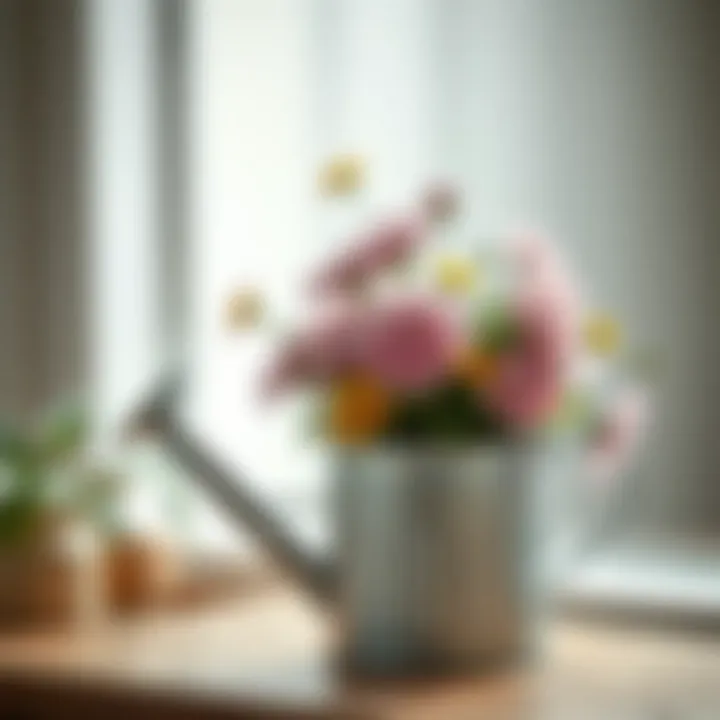
Practical Applications
The small tin watering can is more than just a tool for watering plants; it epitomizes utility infused with artistry. Understanding its practical applications is crucial because it allows both gardeners and decorators to realize its multifaceted nature. In the gardening realm, it shines as an essential item, particularly in urban settings where space and accessibility often dictate choices. Beyond horticulture, its decorative uses transform ordinary living spaces into aesthetically pleasing environments. This section will explore these practical applications, emphasizing its gardening capabilities and decorative functions.
Gardening Use
Watering Technique
When it comes to watering plants, the technique employed can make all the difference. One of the great advantages of using a small tin watering can is the controlled pour it offers. Unlike larger watering systems, it allows gardeners to precisely deliver water right where it's needed, reducing waste and ensuring that moisture reaches the roots.
This specific watering technique fosters healthier plants as it encourages deeper root growth; when roots receive water directly and consistently, they tend to penetrate further into the soil. Additionally, it is easy on delicate plants such as seedlings or flowering pots. If you've ever spilled water all over the ground instead of on your plants, you know the precision a small can provides.
Advantages of the watering technique with a small tin can include:
- Accuracy: You control exactly where the water goes.
- Versatility: Great for various plant types, from succulents to ferns.
- Efficiency: Lesser water waste.
However, its size can also be a limitation. For larger areas, multiple fills may be required, making it less than ideal for expansive gardens. Nevertheless, for smaller projects or indoor gardening, it stands tall.
Plant Types Suitable
Not all plants are created equal when it comes to watering needs. The small tin watering can is particularly suited for plants that flourish with consistent moisture. Houseplants like pothos, peace lilies, and even some herbs benefit greatly from the gentle, measured application of water.
This suitability arises not just from its design but also from its ability to complement the unique needs of different plants. The gradual watering technique is gentle on roots, ensuring less shock to the plant compared to harsher watering styles.
Key characteristics that make certain plants particularly suitable include:
- Moisture-Loving Plants: Ideal for varieties thriving on high humidity and consistent soil moisture.
- Container Plants: Great for indoor pots and small outdoor planters.
On the downside, larger plants or varieties with a higher thirst might not receive enough hydration with a small tin watering can alone. This could mean that while it's brilliant for certain scenarios, it's essential to match the tool to the plants in your care.
Decorative Functions
Centerpiece Ideas
In the realm of design, the small tin watering can finds itself comfortably at home as a cherished centerpiece. Its rustic allure, paired with an array of colors and finishes, allows for bursts of style in varying environments from country chic to contemporary minimalism. When filled with fresh flowers, it doesn’t just serve as decoration; it tells a story of nature brought indoors.
Centerpiece ideas often involve:
- Floral Arrangements: Cute arrangements of seasonal flowers.
- Themed Displays: Use with other rustic elements for events like rustic weddings.
The unique feature of the watering can as a centerpiece is its versatility; whether it’s being used at a summer garden party or as a cozy accent during winter, it continually elevates the visual appeal. Just keep in mind that care should be taken that the can is clean both inside and out to maintain its charm.
Seasonal Decor
With changing seasons, the small tin watering can adapts beautifully. It can become a versatile element in decorating your home, available to you for various themes through the year. Seasonal decor can feature the can in different ways. In spring, you might use it brimming with daffodils; come autumn, it could hold rustic branches or fall leaves.
These seasonal applications promote an ongoing connection with nature and can enhance the aesthetic of both indoor and outdoor spaces. Moreover, they offer a thrifty solution for changing up decor without needing to invest heavily in new items.
Enhancements for seasonal decor include:
- Theme Alignment: Choose specific flowers or arrangements based on seasonal colors.
- Adaptability: Switch from flowers in spring to pine branches in winter effortlessly.
In summary, while the small tin watering can expresses a range of artistic possibilities in home decor, it’s essential to rotate the contents seasonally to keep the interest alive. With thoughtful consideration, the watering can can become a trusted companion in enriching your home’s environment.
Remember, the beauty of decor lies not just in its appearance but also in how well it reflects the character of the space.
Choosing the Right Small Tin Watering Can
Selecting the right small tin watering can can feel like searching for a needle in a haystack, especially with so many choices on the market. Yet, making the right selection is essential for those looking to balance aesthetics and functionality. It’s not just about watering the plants; it's about enhancing your space while ensuring your plants receive the proper care they need.
Key Features to Consider
Size Considerations
When it comes to size, a small tin watering can is typically deemed appealing due to its manageable weight and easy maneuverability. A can that holds around one to two liters is often adequate for most indoor and small garden needs. This specific size can prevent overwatering while providing enough capacity for thorough watering.
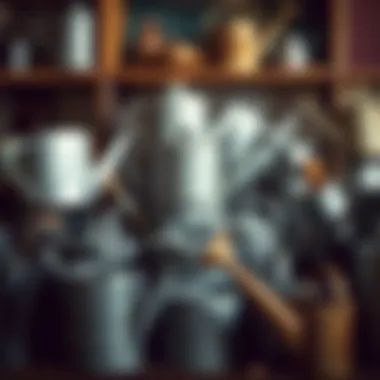

Key characteristic: Portability. A smaller can easily transitions from one plant to another without the user straining their wrist. This benefits both experienced gardeners and those just starting out.
One unique feature of smaller sizes is their ease of storage. They can fit snugly on shelves or in nooks, making them an easy grab when needed without occupying much space. However, the downside might be that if you have a lot of plants, constant refilling could become a hassle.
Spout Design
The spout design significantly contributes to the usability of the watering can. A long, slender spout allows for precision when watering, ensuring that water goes directly to the roots without spilling onto the leaves or surrounding soil. This is crucial, especially for delicate plants that might suffer from excessive moisture on their foliage.
Key characteristic: Accuracy. An optimized spout helps distribute water evenly, catering to various types of plants. Many people choose watering cans with adjustable spouts or removable nozzles for increased versatility, which can transform the watering experience.
However, a spout that is too narrow may make filling the can tricky, creating a potential mess. It’s important to find a good balance between precision and practicality, ensuring that it meets personal gardening needs.
Brand Comparison
Popular Brands
In the market for small tin watering cans, brands such as Haws, Bloem, and Gardman stand out for their quality and design. Each of these brands offers cans in various designs, reflecting both traditional and modern aesthetics. Haws, for example, is often lauded for its craftsmanship and durability, offering cans that not only perform well but look appealing too.
Choosing a reputable brand can provide peace of mind, as they often adhere to higher manufacturing standards. A well-made watering can helps ensure longevity and effectiveness, serving you well for years to come. However, brand recognition sometimes comes at a price, and consumers must weigh the value against their individual needs.
Quality Assessment
Quality assessment goes beyond mere brand comparison. It involves examining the materials and workmanship that go into creating each watering can. A good small tin watering can usually features higher-gauge tin, resulting in a sturdier product.
Key characteristic: Durability. Investing in a high-quality can could save you from frequent replacements, as flimsy models tend to rust and dent easily. A solid can not only withstand the day-to-day rigors of gardening but also serves as a charming decorative piece.
One must be cautious; not all beautiful cans hold up under pressure. Sometimes, impressive designs can come with trade-offs in terms of durability. Thus, reading reviews and seeking user feedback can be instrumental in making an informed decision.
Maintenance and Care
Caring for a small tin watering can is essential to preserve its charm and functionality. Just like any tool or decorative item, regular maintenance ensures that it remains an attractive and useful accessory in your garden or home. A well-cared-for watering can not only looks good but also enhances your gardening experience. The importance of maintenance can’t be overstated; it extends the lifespan of the can and prevents issues like rust, which can quickly mar its appealing appearance. Let’s delve deeper into the specifics.
Cleaning Protocols
Cleaning your small tin watering can might seem like a simple task, but it requires attention and care to avoid damaging the finish. Here are some effective protocols to consider:
- Rinse After Use: After watering plants, it’s a good idea to rinse out the can with clean water to prevent the buildup of mineral deposits. Hard water can leave unsightly stains and can eventually affect the performance when watering delicate plants.
- Gentle Cleaners: During deeper cleaning sessions, avoid harsh chemicals. Instead, use mild soap mixed with warm water. A soft sponge or cloth works wonders, allowing you to scrub away any stubborn dirt without scratching the surface.
- Regular Inspections: Make it a habit to inspect your watering can regularly. Look for any signs of wear or buildup and address them promptly. It’s easier to tackle small spots than let them accumulate into bigger issues.
For those looking to add a personal touch, don’t hesitate to use non-toxic paint sprays designed for metal surfaces. This can revitalize the aesthetic appeal of the watering can, making it a conversation piece in your home.
Preventing Rust
Preventing rust is one of the most critical aspects of caring for a small tin watering can. Rust not only compromises the structural integrity of the can but also detracts from its visual appeal. Here’s how to keep that rust at bay:
- Store Properly: Ensure that your watering can is stored in a dry location. Avoid leaving it outside for extended periods, especially in wet or humid weather, as moisture is the enemy of metal.
- Dry Thoroughly: Each time you wash your can, make sure it is dried completely. Water left trapped in hard-to-reach areas can lead to rust formation. Give it a good shake and use a clean cloth to wipe it down.
- Apply a Protective Coating: Consider using a clear sealant or wax specifically designed for metal. This can provide an additional layer of protection against moisture and other elements.
Remember, a bit of proactive care today can save you from a bigger headache tomorrow. Keeping your watering can rust-free not only prolongs its life but also keeps your gardening tasks enjoyable and stylish.
In summary, a little maintenance goes a long way with a small tin watering can. Regular cleaning and rust prevention strategies will ensure that this charming piece serves you well for years to come.
Environmental Considerations
As we become more aware of the environmental impact of our choices, the focus on sustainability is more crucial than ever. The small tin watering can is not just a tool for nurturing our gardens, but it also carries significant implications for environmental stewardship. Understanding these implications can lead homeowners, designers, and DIY enthusiasts alike to make informed decisions that benefit both their space and the planet.
Sustainable Sourcing
When it comes to the production of small tin watering cans, sustainable sourcing is a significant part of the conversation. The materials that go into these watering cans can greatly affect the environment.
Crafted mainly from tin, a metal that is frequently recycled, the environmental footprint can be quite low. Many manufacturers now prioritize obtaining their tin from responsible suppliers who follow ethical mining practices. This means that the mining operations not only minimize damage to ecosystems but also ensure the fair treatment of workers involved in extracting these materials.
Additionally, companies may use local sources to reduce carbon emissions associated with transport. In places where manufacturing adheres to strict environmental regulations, like certain regions in Northern Europe, the impact on the planet can be significantly mitigated.
Moreover, by investing in watering cans made from sustainably sourced materials, consumers can play their part in supporting eco-friendly practices. This fosters a circular economy where reused and recycled materials become the norm, ultimately leading to a decrease in reliance on virgin materials.
Recyclability
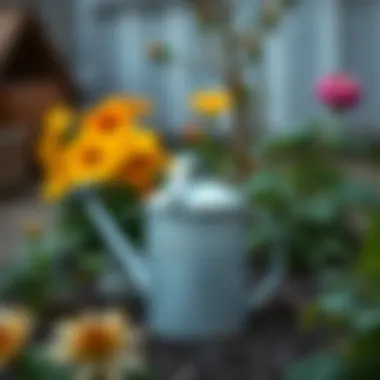
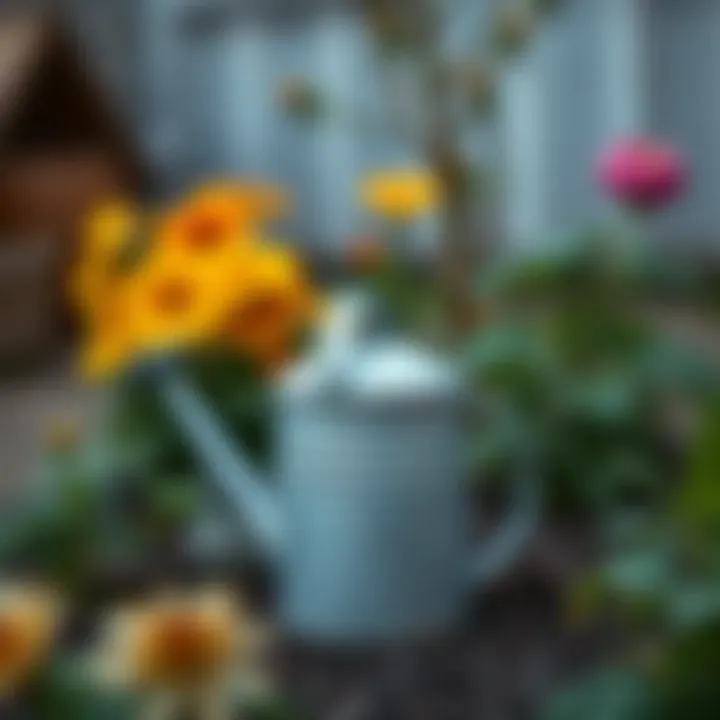
In this age of throwaway items, the recyclability of products is paramount. A small tin watering can stands out in this category. Unlike its plastic counterparts, which often end up in landfills for centuries, tin can be recycled almost indefinitely without losing its quality. This property allows for a sustainable life cycle.
Once a tin watering can reaches the end of its life, it can be melted down and reformed into new products. This process is energy-efficient compared to creating new materials, thereby conserving resources. Emphasizing recyclability can significantly lessen the environmental wastage, which is something discerning consumers are increasingly prioritizing in their purchasing decisions.
DIY Ideas with a Small Tin Watering Can
The small tin watering can isn’t just a simple tool for watering plants; it can become an outlet for creativity and personal expression. DIY projects utilizing this versatile item not only enhance its functionality but also allow individuals to add a personal touch to their home. Whether you aim to make a statement piece in your garden or a functional work of art for decoration, the possibilities are endless. Incorporating DIY ideas into your use of the small tin watering can can transform it from mundane to extraordinary, providing both aesthetic and practical benefits.
DIY Decor Projects
Paint and Personalize
Painting and personalizing a small tin watering can offers a chance to express oneself in a colorful and unique way. This option stands out because it isn’t just about slapping on any old paint; it's about creating a piece that matches your aesthetic. Personalized designs can turn a common object into something truly special, making it a beloved addition to any home.
The process involves choosing colors that resonate with your decor or perhaps even using stencils to create intricate designs. One might decide to use weather-resistant paint, ensuring that the creation withstands the elements if placed outdoors.
"Personalizing your watering can enhances its beauty and reflects your personality. It can garner compliments from visitors, making it not just useful but also a conversation starter."
However, one must be cautious with materials. Some paints may chip or fade over time, so sourcing high-quality products is essential. Ultimately, the initiative to paint and personalize the watering can provides not only a beneficial way to beautify but also enriches the overall purpose, making it more than just a garden tool.
Functional Art
Functional art is an apt description when it comes to using a small tin watering can creatively. Turning it into functional art means using it for its intended purpose while also enhancing its visual appeal. Think of transforming an ordinary watering can into something artistic that still fulfills the need for watering your plants.
A key characteristic of functional art is its duality: it serves a purpose while simultaneously embellishing a space. A beautifully arranged bouquet of seasonal flowers inside a watering can can add vitality to your kitchen or patio. Using it this way provides a unique way to display nature while maintaining the object’s watering functionality.
On the downside, one must strike a balance between aesthetics and usability, ensuring that the watering can still maintains its primary role and doesn’t become too decorative to perform its function. Nevertheless, functional art surrounding small tin watering cans offers a delightful fusion of beauty and practicality, making it a popular choice among home enthusiasts and gardeners alike.
Crafts for Children
Crafting with children using small tin watering cans opens up a world of imagination and engagement. This activity not only fosters creativity but also aids in developing fine motor skills as kids paint, personalize, or transform these cans.
It’s a hands-on project that can teach kids about gardening, responsibility, and caring for plants. Moreover, using the tins as planters can encourage them to appreciate nature and understand where food comes from. Encouraging children to connect with the environment through crafting provides a valuable life lesson. Each watering can crafted can become a cherished memory, adding layers of sentiment to its utilitarian form.
Comparative Analysis with Other Watering Solutions
When it comes to watering plants, not all tools are created equal. The small tin watering can has its own set of unique advantages, but how does it stack up against other solutions like plastic or ceramic options? This section will delve into these comparisons, helping homeowners, designers, and DIY enthusiasts understand the pros and cons of each choice.
Plastic Watering Cans
Plastic watering cans have been a popular choice for many gardeners, and it's easy to see why. They're lightweight and typically more affordable than their tin counterparts, making them accessible for casual gardeners. However, several key factors set them apart from small tin watering cans.
Durability
While plastic is generally resistant to rust or corrosion, its lifespan can be shorter due to fading caused by UV exposure. As a result, plastic cans can become brittle over time, cracking or snapping under stress. In contrast, small tin watering cans tend to be sturdier, especially when maintained properly. They carry a timeless quality that plastic just can't replicate.
Aesthetic Value
One cannot overlook the aesthetic appeal of a small tin watering can. Many plastic options are often limited in design, typically available in bright colors or basic shapes. On the other hand, tin watering cans can boast charming vintage designs, handcrafted details, and a variety of colors that add character to any garden setting.
The difference isn’t just on the surface; it can speak volumes about the homeowner’s sense of style.
Environmental Concerns
Plastic is notorious for its environmental impact. Though some recycling options exist, many plastic watering cans can end up in landfills, contributing to pollution. In contrast, tin watering cans, when they reach the end of their life, are usually completely recyclable, making them a more sustainable option.
Ceramic Options
Ceramic watering cans also present a fascinating alternative to both plastic and tin. With their rich artistry and often vibrant colors, ceramic cans can be true statement pieces in any garden. However, they come with their own set of strengths and weaknesses.
Weight and Balance
Ceramic cans tend to be heavier than both plastic and tin counterparts, which could be a disadvantage, especially when full of water. This weight can make them less portable. In comparison, a small tin watering can strikes a balance between durability and weight, making it easier to maneuver without sacrificing strength.
Thermal Regulation
One interesting aspect to consider is thermal conductivity. Ceramic can hold heat longer than tin, which might impact plant health during extremely hot conditions. Conversely, tin can release heat when out in the sun, keeping water cooler for longer use.
Breakability
Lastly, while ceramic watering cans may feature exquisite designs, they can be prone to breaking if dropped. In contrast, a small tin watering can can endure minor bumps and bruises without much worry. It's designed for practical use, making it user-friendly for both the casual gardener and the seasoned expert.
"Considering the material and design of your watering can is key to understanding its functionality and suitability for your gardening needs."
Ultimately, the choice of watering can depends significantly on individual preferences. Each option presents distinct advantages, but when you weigh factors like aesthetics, durability, and ecological impact, the small tin watering can emerges as a versatile and dynamic choice for various gardening needs.
The End
The small tin watering can may seem like a simple tool at first glance, yet its benefits extend far beyond merely dousing plants with water. This article has explored several key aspects that underline just how significant this humble vessel can be in both horticultural practices and in home decor. The watering can’s unique historical background lends itself to a treasure trove of cultural insights. We’ve seen how it serves as a bridge, connecting generations of garden enthusiasts while maintaining relevance in today’s eco-conscious world.
Recap of Key Points
- Historical Significance: The small tin watering can has roots that trace back centuries, embodying the essence of gardening culture across time and locations.
- Functional Design: Constructed from durable materials, its design incorporates various features like size and spout shape that cater to specific watering needs.
- Aesthetic Qualities: With a range of colors and design styles, this can serves as both a practical tool and an attractive decorative element within homes and gardens.
- Versatility in Use: It’s not just about watering; these cans can function as charming centerpieces, seasonal decor, or even as part of DIY art projects.
- Environmental Aspects: Sustainability is a growing concern, and the small tin watering can highlights this through its recyclability and traditional craftsmanship.
Final Thoughts on Usage
When it comes to choosing a small tin watering can, it’s essential to go beyond just picking one that looks good. Homeowners and DIYers should consider factors like size, spout design, and the intended plants to ensure effectiveness. Whether you're watering thriving flowers or using it as an ornamental feature, this piece truly adds value. As you ponder where to place it—perhaps on a windowsill or as part of your patio decor—consider how this unassuming tool can enhance both functionality and beauty in your space. Remember, every small detail in your gardening or design efforts contributes to a bigger picture—enabling you to cultivate not just plants, but also a lifestyle steeped in appreciation for craftsmanship and thoughtful aesthetics.















